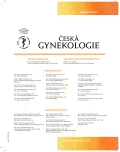Placenta percreta as a cause of massive intraabdominal bleeding
Authors:
M. Rolná 1; P. Matlák 1,2; J. Dvořáčková 3
Authors‘ workplace:
Gynekologicko-porodnická klinika FN, Ostrava, přednosta doc. MUDr. O. Šimetka, Ph. D., MBA
1; Gynekologicko-porodnická klinika LF OU, přednosta doc. MUDr. O. Šimetka, Ph. D., MBA
2; Ústav patologie FN, Ostrava, přednostka doc. MUDr. J. Dvořáčková, Ph. D.
3
Published in:
Ceska Gynekol 2017; 82(6): 478-481
Overview
Objective:
To inform about a rare cause of massive intraabdominal bleeding due to perforation of uterine corner by unrecognized placenta percreta.
Design:
Case report.
Setting:
Department of Gynecology and Obstetrics, University Hospital Ostrava.
Case report:
We report a case of acute haemoperitoneum in pregnant woman at 34th week of gestation. We have detected the cause of the bleeding during emergency caesarean section – perforation of left uterine corner by placenta percreta.
Conclusion:
Placenta percreta is the most severe form of abnormal placental villous adherence. In rare cases, chorionic villi may penetrate surrounding organs and cause acute intraabdominal bleeding. Due to increasing number of surgical interventions on uterus, these disorders are on the rise. It is crucial to anticipate an abnormal placental villous adherence in women with atypical placenta localization. These women should be thoroughly observed and referred to perinatal center with intermediary or intensive care for further management before delivery.
Keywords:
placenta percreta, hemoperitoneum, caesarean section, postpartum hysterectomy
Sources
1. Breen, JL., Neubecker, R., Gregori, CA., et al. Placenta accreta, increta, and percreta: a survey of 40 cases. Obstet Gynecol, 1977, 49, 1, p. 43–47.
2. Fitzpatrick, KE., Sellers, S., Spark, P., et al. Incidence and risk factors for placenta accreta/increta/percreta in the UK: a national case-control study. Plos One, 2012, 7, 12, p. 1–6.
3. Hudon, L., Belfort, MA., Broome, DR., et al. Diagnosis and management of placenta percreta: a review. Obstet Gynecol Surg, 1999, 54, 11, p. 156–164.
4. Chattopadhyay, SK., Kharif, H., Sherbeeni, MM., et al. Placenta praevia and accreta after previous caesarean section. Eur J Obstet Gynecol Reprod Biol, 1993, 52, 3, p. 151–156.
5. Chou, M., Ho, ESC., Lee, YH. Prenatal diagnosis of placenta previa accreta by transabdominal color Doppler ultrasound. Ultrasound Obstet Gynecol, 2000, 15, 1, p. 28–35.
6. Miller, DA., Chollet, JA., Goodwin, JA. Clinical risk factors for placenta previa – placenta accreta. Am J Obstet Gynecol, 1997, 177, 1, p. 210–214.
7. Morken, NH., Henriksen, H. Placenta percreta-two cases and review of the literature. Eur J Obstet Gynecol Reprod Biol, 2001, 100, 1, p. 112–115.
8. O‘brien, JM., Barton, JR., Donaldson, ES., et al. The management of placenta percreta: conservative and operative strategies. Am J Obstet Gynecol, 1996, 175, 6, p. 1632–1638.
9. Šimetka, O. Břišní těhotenství. In Roztočil, A., a kol. Moderní porodnictví. Praha: Grada, 2017, s. 566.
10. Usta, IM., Hobeika, EM., Musa, AAA., et al. Placenta previa-accreta: risk factors and complications. Am J Obstet Gynecol, 2005, 193, 3, p. 1045–1049.
11. Warshak, CR., Eskander, R., Hull, AD., et al. Accuracy of ultrasonography and magnetic resonance imaging in the diagnosis of placenta accreta. Obstet Gynecol, 2006, 108, 3, p. 573–581.
12. Washecka, R., Behling, A. Urologic complications of placenta percreta invading the urinary bladder: a case report and review of the literature. Hawaii Med J, 2002, 61, 4 p. 66–69.
Labels
Paediatric gynaecology Gynaecology and obstetrics Reproduction medicineArticle was published in
Czech Gynaecology

2017 Issue 6
Most read in this issue
- External cephalic version of breech fetus after 36 weeks of gestation – evaluation of efectiveness and complications
- Aspiration of functional ovarian cyst
- DNA quality of spermatozoa is negatively affected by male age and represents a risk factor for conception
- Placenta percreta as a cause of massive intraabdominal bleeding
